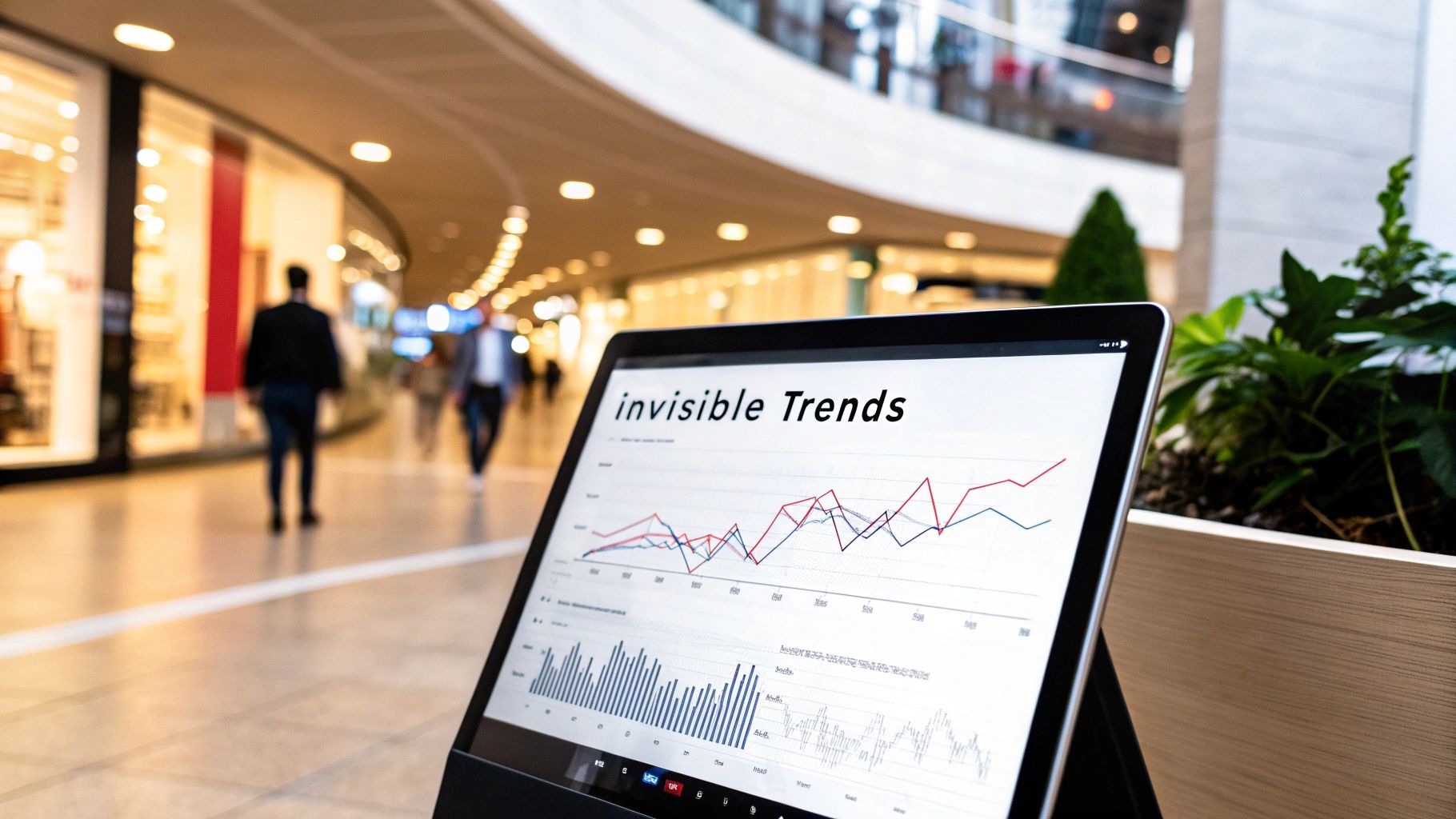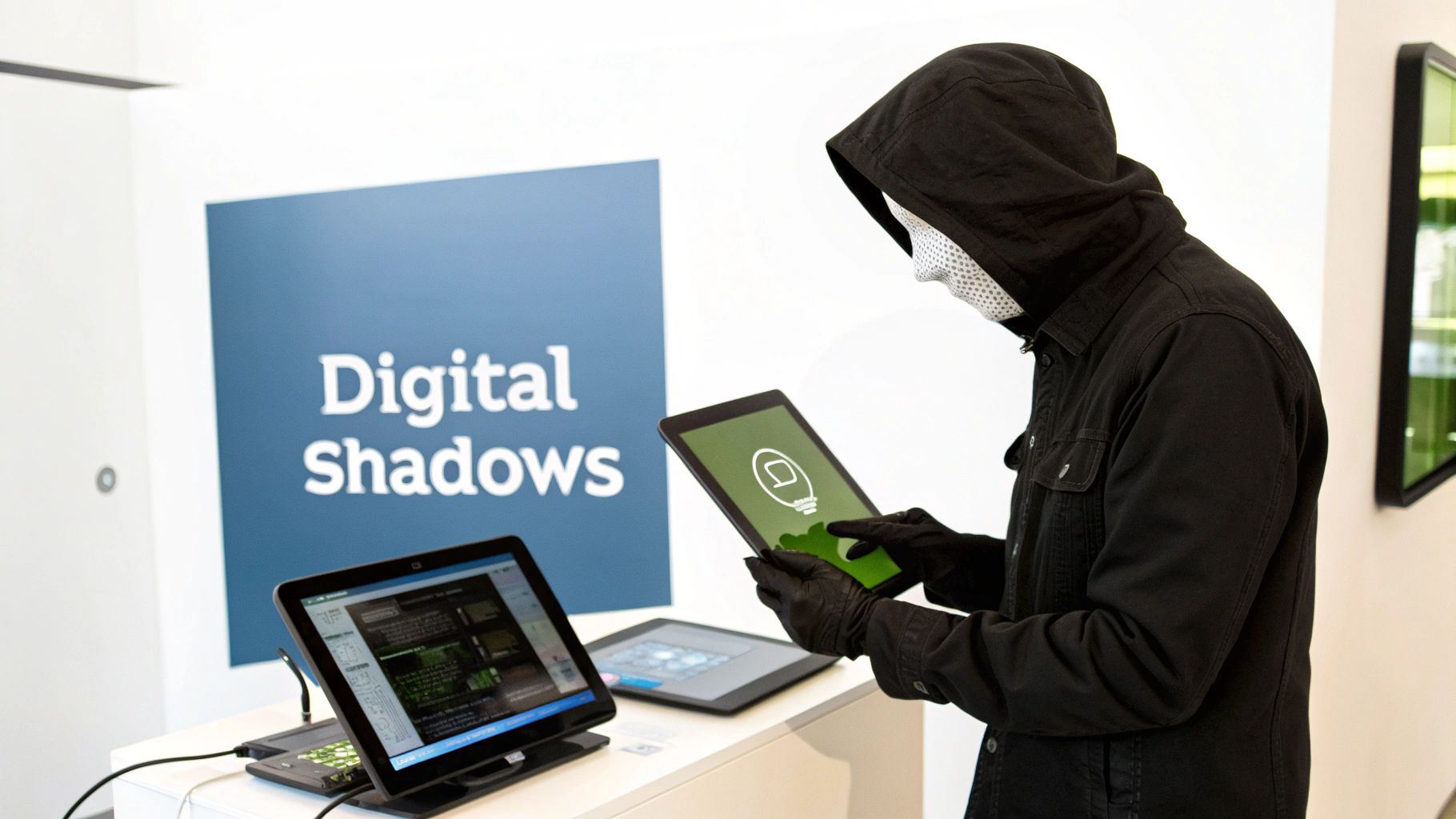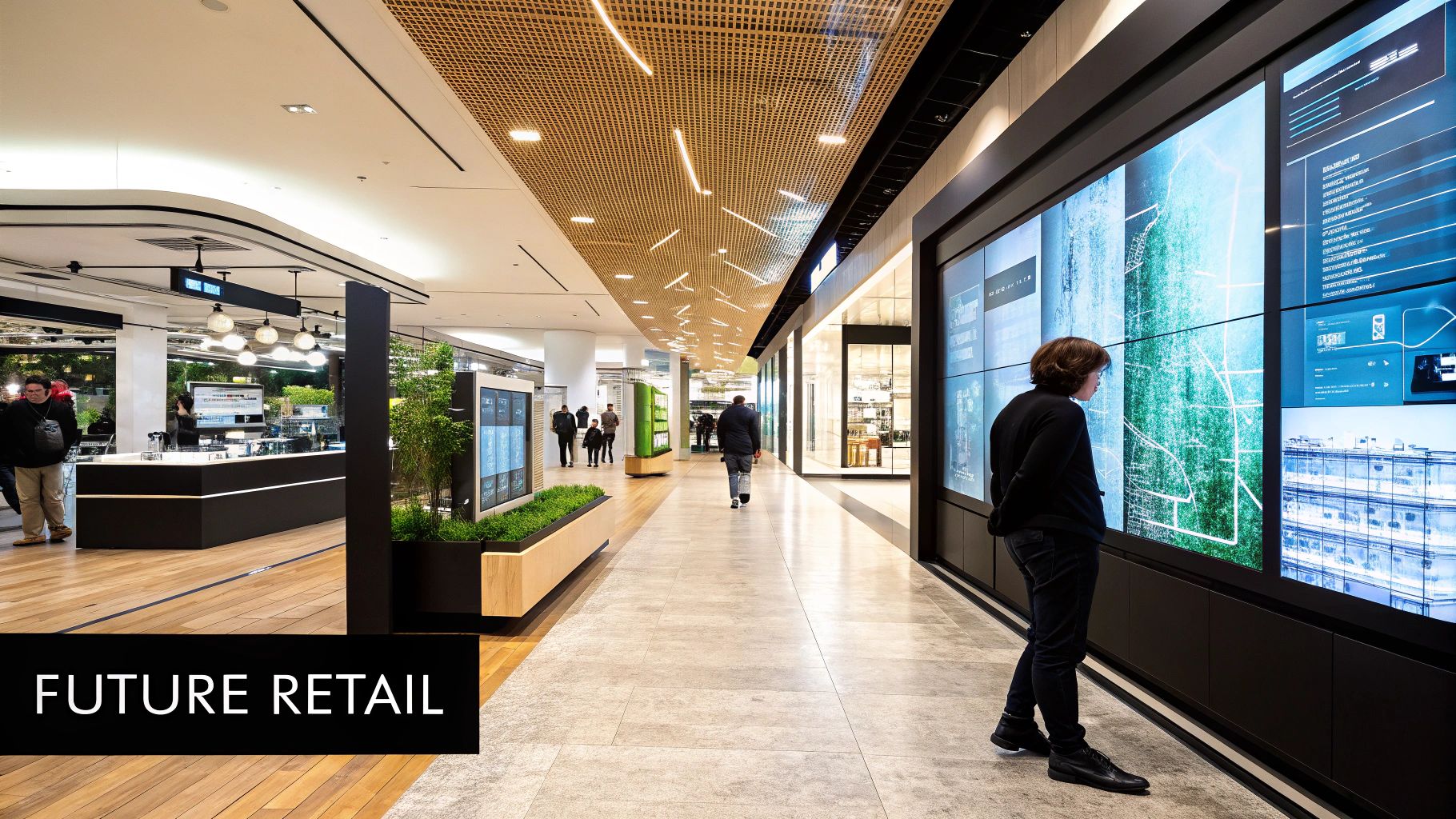The Ghost Commerce Revolution: Beyond Traditional Retail

Ghost commerce is changing the way we think about online selling. This business model skips the traditional storefront and physical inventory, letting entrepreneurs concentrate on marketing and sales. Logistics and fulfillment are handled by third-party partners, creating a leaner and more agile business operation. This frees up entrepreneurs from the burdens of warehousing and inventory management.
Understanding the Ghost Commerce Model
Several key approaches make this model work. Each offers distinct advantages for online businesses:
- Dropshipping: Partnering with suppliers who manage inventory and ship products directly to customers. The ghost commerce entrepreneur focuses on marketing and customer service.
- Print-on-Demand: Creating and shipping custom-designed products only after an order is placed. This approach eliminates the need for upfront inventory investments. Think t-shirts, mugs, and phone cases.
- Affiliate Marketing: Earning commissions by promoting other companies' products. Entrepreneurs drive traffic to affiliate websites and receive a percentage of sales generated. A strong online presence and engaged audience are essential for this model.
Ghost commerce is appealing because of its accessibility. It lowers the barrier to entry for aspiring entrepreneurs. With minimal upfront investment, businesses can experiment with products and markets without the financial risks of traditional retail.
The Rise of Zero-Inventory Businesses
Ghost commerce is part of a larger trend: the growth of zero-inventory businesses. This movement prioritizes digital marketing, customer relationships, and efficient operations. It reduces the emphasis on managing physical products.
This allows entrepreneurs to invest resources in brand building and customer connections instead of complex logistics. For instance, a ghost commerce business selling phone accessories might focus on creating captivating content about mobile photography. This drives traffic to their website without ever physically handling a phone case.
This rise in zero-inventory models is tied to the overall growth of e-commerce. Global retail e-commerce sales reached $5.8 trillion in 2023. Projections show this number growing by 39% to over $8 trillion by 2027. This provides a great environment for ghost commerce. It allows businesses to operate online without inventory or physical stores, catering to consumer demand for online convenience and personalized products. For a closer look at the growth of ghost commerce, learn more here.
The Mindset Shift for Ghost Commerce Success
Ghost commerce isn't a get-rich-quick scheme. Success demands a different mindset than traditional retail. Entrepreneurs need strong skills in digital marketing, customer relationship management, and supplier coordination.
Building trust and brand loyalty is also crucial when you don't physically handle the products. Clear communication, dependable suppliers, and exceptional customer service build credibility. This fosters the strong customer relationships needed for sustainable growth in the ever-changing world of ghost commerce.
The Financial Edge of Ghost Commerce

Ghost commerce offers significant financial advantages over traditional retail. One of the most compelling benefits is improved cash flow. Instead of tying up capital in inventory, ghost commerce entrepreneurs receive customer payments before paying suppliers.
This creates a self-funding system that fuels growth and minimizes financial risk. Businesses can reinvest profits immediately, scaling operations much faster than traditional businesses burdened by inventory costs.
Another key advantage is cost-effectiveness and scalability. With no physical inventory or storefronts, startup costs are significantly lower. This allows businesses to launch with minimal investment and scale rapidly.
For example, the absence of inventory costs allows ghost commerce entrepreneurs to focus on marketing and customer service, enhancing their online presence. Find more detailed statistics here.
Higher Profit Margins and Reduced Risk
This unique financial structure translates directly into higher profit margins. Entrepreneurs are seeing 30-60% higher profits compared to traditional models. This increase is due to the elimination of several key expenses:
- Warehousing: No need for expensive storage space.
- Inventory Management: Eliminates stocktaking and obsolescence costs.
- Shipping Supplies: These costs are absorbed by the supplier.
The reduced financial risk associated with ghost commerce also allows businesses to be more agile. They can experiment with new product lines and marketing strategies without large inventory write-offs. This adaptability is a significant advantage in today's dynamic online marketplace. You might be interested in: How to Increase Sales on Shopify.
Calculating Your Potential Savings
The specific savings will vary by business and niche, but the potential for cost reduction is substantial. Imagine a traditional retailer spending 15% of revenue on warehousing and another 10% on inventory management. These costs could be virtually eliminated with a ghost commerce model.
To illustrate, let's look at a simple comparison:
Ghost Commerce vs. Traditional E-commerce: A comparison of startup costs, operational expenses, and profit margins between ghost commerce and traditional e-commerce business models.
| Cost Category | Traditional E-commerce | Ghost Commerce | Savings Potential |
|---|---|---|---|
| Warehousing | $15,000 | $0 | $15,000 |
| Inventory Management | $10,000 | $0 | $10,000 |
| Total Savings | $25,000 |
This table highlights the substantial cost savings achievable with ghost commerce, directly impacting profitability. In this example, a business could save $25,000 by switching to ghost commerce.
Established Brands Embracing the Change
Even established brands are recognizing the power of ghost commerce. Many are shifting portions of their catalogs to inventory-free fulfillment strategies. This allows them to test new product lines or enter new markets with minimal risk.
This trend validates the viability and long-term potential of the ghost commerce model. This financial flexibility attracts businesses of all sizes, driving the continued growth of the ghost commerce landscape.
Winning Ghost Commerce Models That Actually Work

Not all ghost commerce strategies are created equal. Some flourish, while others struggle. This section explores proven ghost commerce models that deliver tangible results. We'll focus on their practical applications and key performance indicators.
Dropshipping: Finding Your Niche
Dropshipping remains a popular ghost commerce model. However, success depends heavily on finding the right niche. Identifying underserved markets with specific product needs is key.
Instead of a broad category like "pet supplies," consider specializing. Focusing on something like "eco-friendly reptile accessories" can tap into a passionate, less competitive market.
This targeted approach allows for more effective marketing. You can cultivate stronger customer engagement. By specializing, you become a trusted authority within your chosen niche.
Print-on-Demand: Maximizing Profit Margins
Print-on-demand offers impressive profit potential with no inventory costs. Choosing the right products is essential for success.
High-margin items, such as all-over print apparel or personalized home decor, tend to outperform basic t-shirts. Consider offering unique designs.
Partnering with artists can elevate your product's perceived value. This allows for higher pricing and, in turn, stronger profit margins. Focus on quality and design to differentiate your offerings.
Digital Products: Scalability and Efficiency
Selling digital products is a highly scalable ghost commerce model. Products like online courses, ebooks, or software can be delivered instantly and automatically. This minimizes fulfillment overhead.
This model offers unmatched scalability. Since there are no physical production or delivery limitations, serving an additional customer adds minimal extra cost. This can lead to significant profit growth as your customer base expands. Learn more in our article about What is digital dropshipping?.
Subscription Commerce: Predictable Revenue Streams
Adapting subscription commerce to the ghost commerce model offers predictable revenue. Partner with a dropshipping supplier to offer curated subscription boxes in a defined niche.
This approach provides recurring revenue and fosters stronger customer relationships. A monthly subscription box featuring artisanal coffee beans, for instance, could cater to coffee enthusiasts. This cultivates a loyal customer base.
Supplier Relationships: The Key to Success
Across all ghost commerce models, strong supplier relationships are paramount. This includes clear communication, reliable fulfillment, and shared quality standards.
Building these relationships requires consistent communication and clearly defined expectations. It involves regular check-ins and proactive problem-solving.
These relationships have a direct impact on customer satisfaction. Careful supplier selection is crucial. A foundation of trust with your suppliers is essential for long-term success in ghost commerce. It ensures smooth operations and a positive customer experience.
Building Your Ghost Commerce Roadmap

Turning a ghost commerce idea into a profitable business takes planning and effort. This roadmap covers key steps, from validating your market to maintaining quality control, guiding you toward building a thriving ghost commerce business.
Validating Your Market Opportunity
Before you launch, it’s essential to validate your market. This means researching demand, competition, and potential profit in your niche. For example, if you're selling pet products, look closely at specific needs within that market.
Are some segments underserved? Perhaps there's a demand for eco-friendly dog toys or specialized cat grooming tools. Identifying a specific need allows for targeted marketing and better customer engagement. A well-defined niche is always more effective than a broad, competitive market.
Identifying Reliable Suppliers
Dependable suppliers are the backbone of any ghost commerce business. Finding them takes more than a quick search online; thorough vetting is crucial. Look for suppliers with a strong track record of quality products, on-time delivery, and clear communication.
Choosing a supplier is like choosing a business partner. You need someone reliable. Their reliability directly impacts customer satisfaction. Look for clear communication, efficient processes, and a shared commitment to quality.
Building Your Technology Stack
The right technology is essential for smooth ghost commerce operations. This includes your e-commerce platform, marketing automation tools, and CRM system. Apps like LinkShop, a link-in-bio tool for Shopify merchants, can boost your online presence.
LinkShop lets you create attractive, shoppable link-in-bio pages, giving customers easy access to your products. It's a strong alternative to platforms like Linkpop. The right tools streamline your workflow and improve the customer experience, allowing you to focus on growth.
Customer Acquisition Strategies for Ghost Commerce
Attracting customers in a zero-inventory business requires a unique approach. Content marketing is vital. By creating valuable content related to your niche, you can build authority and draw in potential buyers.
This could include blog posts, how-to videos, or engaging social media posts. This approach builds trust and positions you as an expert, even without physical inventory.
Brand Positioning and Quality Control
Even without physical products, a strong brand identity is crucial. This means defining your values, telling a compelling brand story, and consistent messaging across all platforms.
Quality control is equally important. While you don't handle products directly, your brand's reputation depends on the quality of what your suppliers provide. Put strict quality control systems in place with your suppliers.
This should include clear product specs, regular quality checks, and a system for handling returns and customer issues. This protects your brand and ensures consistent customer experiences.
To help you compare different platforms for ghost commerce, take a look at the table below:
Ghost Commerce Platform Comparison
Analysis of leading platforms and tools that support ghost commerce operations, including features, pricing, and best use cases
| Platform | Best For | Key Features | Price Range | Integration Options |
|---|---|---|---|---|
| Shopify | Businesses of all sizes | Scalable, easy to use, large app store | $29 – $299+ per month | Numerous apps and integrations |
| BigCommerce | Fast-growing businesses | Robust features, headless commerce capabilities | $29.95 – $299.95+ per month | Open APIs and webhooks |
| Squarespace | Small businesses, creatives | Simple setup, beautiful templates | $16 – $49 per month | Limited integrations |
| WooCommerce | WordPress users | Flexible, open-source | Free (hosting and extensions cost extra) | Extensive plugin library |
| Gumroad | Creators, digital product sellers | Simple platform for selling digital downloads | Free – 10% per transaction | Limited integrations |
This table provides a quick overview of popular ghost commerce platforms. Each platform has its strengths and weaknesses, so choosing the right one depends on your specific needs and business goals. Consider factors like scalability, ease of use, features, and pricing when making your decision.
Conquering Ghost Commerce Obstacles
Ghost commerce, while offering appealing benefits, comes with its own set of challenges. Tackling these directly is essential for creating a sustainable and profitable business. Let's explore some common obstacles and how successful ghost commerce entrepreneurs overcome them.
Supplier Reliability: Building a Strong Foundation
Supplier reliability is paramount in ghost commerce. Problems like shipping delays or quality control issues can seriously damage your brand’s reputation, even if you aren’t directly handling fulfillment.
This means you need proactive communication and clear expectations with your suppliers. Set up a system for regular check-ins, performance reviews, and open discussions about potential issues. Treat your supplier as a partner, not just a vendor.
This collaborative approach builds trust and makes sure everyone is working towards the same goal: happy customers.
Managing Shipping Delays: Transparency and Communication
Shipping delays are inevitable in e-commerce, including ghost commerce. When delays happen, proactive communication with your customers is critical.
Keep customers informed instead of leaving them wondering where their order is. Provide realistic delivery estimates upfront and quickly notify them of any changes. Transparency builds trust and reduces the frustration of unexpected delays. This open communication fosters understanding and strengthens customer relationships.
Quality Control: Setting Standards and Following Through
Maintaining consistent quality when you don't physically handle products requires careful planning. Establish clear quality standards with your suppliers and implement systems for regular checks.
This could involve random product inspections, customer feedback analysis, or a combination of both. Check out our guide on shoppable content.
This proactive approach minimizes the risk of quality issues affecting your customers. Addressing potential problems early prevents bigger headaches down the road. By ensuring product quality, you protect your brand and build customer loyalty.
Maintaining Brand Consistency: Owning Your Identity
Maintaining a consistent brand identity in ghost commerce can be tricky. While you don’t control the entire fulfillment process, you do control your brand’s messaging, visuals, and customer interactions.
Focus on creating a strong brand voice and visual identity that’s consistent across every platform. This could include custom packaging inserts, personalized thank-you notes, or a dedicated customer service team trained to represent your brand values.
These small touches create a cohesive brand experience, even without physical products. This builds brand recognition and customer loyalty, solidifying your place in the competitive zero-inventory market.
Standing Out in Competitive Markets: Differentiation and Value
The low barrier to entry in ghost commerce means more competition. To succeed, you must offer something unique. This could mean specializing in a niche market, providing exceptional customer service, offering personalized products, or building a strong community around your brand.
Concentrate on building authentic relationships with your customers. This might involve creating valuable content related to your niche, offering exclusive discounts, or hosting online events. By focusing on what makes your business special, you create a unique value proposition that connects with customers and helps you stand out from the competition.
The Future of Ghost Commerce
Ghost commerce, built on zero-inventory models, is constantly changing. Emerging technologies and evolving consumer behaviors mean staying ahead of the curve is essential for long-term success.
AI-Powered Personalization
Artificial intelligence (AI) is changing how ghost commerce businesses personalize the customer experience. AI algorithms analyze customer data to recommend products, create targeted marketing campaigns, and even offer personalized pricing. Imagine AI recommending a specific dog toy based on a customer's past purchases and browsing history, even if the business doesn't physically stock any inventory. This personalized approach strengthens customer connections and drives sales.
Blockchain and Supplier Relationships
Blockchain technology can revolutionize supplier relationships in ghost commerce. By creating transparent and secure transaction records, blockchain builds trust and streamlines communication between businesses and suppliers. This can lead to faster order fulfillment, better quality control, and even automated payments. Smart contracts, enabled by blockchain, can automate processes like order tracking and dispute resolution, reducing friction and increasing efficiency.
Augmented Reality Bridging the Physical Gap
Augmented reality (AR) offers ghost commerce businesses a powerful way to bridge the physical product gap. By allowing customers to visualize products in their own environment through AR apps, businesses enhance the online shopping experience. Imagine a customer using AR to see how furniture would look in their living room before buying it from a dropshipping store. This immersive experience boosts buyer confidence and reduces the uncertainty of online shopping. This technology also creates a stronger emotional connection with the product, ultimately driving sales.
Emerging Growth Models and Regulatory Changes
Certain ghost commerce models, like subscription boxes and personalized product services, are expected to grow rapidly. This growth may attract regulators, leading to potential changes in taxation and consumer protection. Staying informed about emerging regulations is essential for navigating the evolving ghost commerce landscape. Businesses that anticipate these changes can adapt quickly and maintain a competitive edge.
Forward-thinking entrepreneurs are already capitalizing on these future trends. They're exploring how AI can enhance marketing, researching blockchain solutions for supply chain management, and experimenting with AR to showcase products. By embracing these changes, they aren't just keeping up with the competition – they're shaping the future of ghost commerce.
Ready to improve your Shopify store's online presence? LinkShop is the link-in-bio tool built for you. Create beautiful, shoppable link-in-bio pages that drive sales and engage your customers. It's a more powerful alternative to platforms like Linkpop. Visit LinkShop today to learn more.
